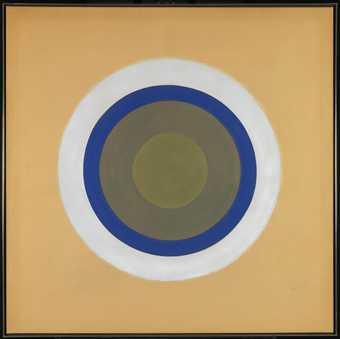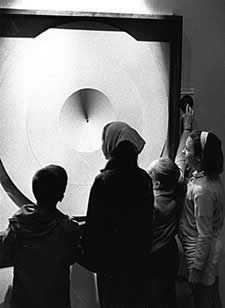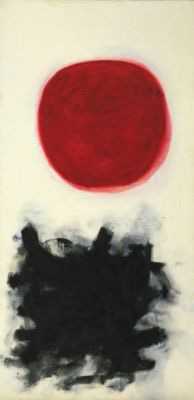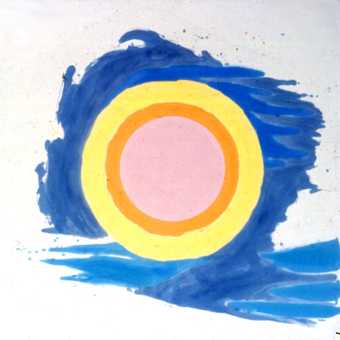
Fig.1
Kenneth Noland
Gift 1961–2
Acrylic on canvas
1829 x 1829 mm
Tate T00898
© The estate of Kenneth Noland /VAGA, New York/DACS, London 2016
‘I’m a one-shot painter’, Kenneth Noland told Time magazine in 1965.1 It was a turn of phrase he had used to describe his techniques since at least the early 1960s and that referred to his ‘discovery’ and development of the stain technique in the early 1950s in contrast to more traditional ways of painting, in which layers of paint are built up on a primed canvas. What might it mean to view Gift 1961–2 (Tate T00898; fig.1) as a one-shot painting? Certainly the phrase resonates with the reading of its concentric circles as a target and all the suitably avant-garde implications of the military and the ballistic that this might entail. In reconsidering the ramifications of this term this essay takes its lead from critic and curator Lawrence Alloway, who claimed that ‘Noland’s circles, whatever he may have intended, never effaced our knowledge, built-in and natural by now, of circular systems of various types’.2 Alongside such formal analogies, Noland’s concept of one-shot painting can also be productively understood in relation to a wide range of fields in which American cultural discourse in the 1950s and 1960s expressed its expansive faith in progress and the possibilities of the future.
The primary meaning of the ‘one-shot’ idea concerned the way Noland made his paintings. Unlike a traditional primed canvas, which allowed an artist to scrape off or paint over unsuccessful passages, his use of a raw canvas whose warp and weft was soaked with diluted pigment meant that his paintings could not be easily revised. Moreover, the visibly uniform and usually singular tint of Noland’s stained bands declared this fact: not only were they unrevised, but they looked it. Noland’s guiding example was the late black paintings of Jackson Pollock (see, for instance, Pollock’s 1952 Yellow Islands, Tate T00436). ‘Pollock’s black enamel was stained directly into the raw canvas. The paint was thrown once and once only’, Noland explained of his predecessor’s influence.3 The idea emerges not only as a formal strategy, but also as an aspiration to work with unshakeable confidence, having the strength of mind to resist the temptation to make alterations. As Noland explained elsewhere, the idea ‘was “to get it right the first time” without second guessing’.4 One-shot painting, then, identified Noland as an artist who could stick to his guns.
Art historian Marcia Brennan has explored the gendered dynamics of such an account. Considering Noland and Louis’s appropriation of the stain technique from Helen Frankenthaler, Brennan casts the idea of ‘one-shot’ painting – ‘an activity in which the artist’s fluid deposits are absorbed onto a soft, receptive ground’, she writes – as one with ‘ejaculatory connotations’.5 Perhaps this goes too far, but the machismo of Noland’s terms does chime with a broader, and no less problematically gendered, valorisation of productivity in the post-war decades. As Noland explained the one-shot concept to filmmaker Emile de Antonio in the early 1970s:
Morris [Louis] and I used to talk about what we called one-shot painting. I guess it had to do with the fact that if you were impressed with what you were doing, you only had to do it one time if you could get yourself together so that each thing that you did was just done that one time with no afterthoughts and it had to stand.6
The speed of the stain technique further supported Noland’s ambitions, as he explained in a 1971 interview, helping not only ‘to do the work as easily as possible’ but also ‘to do more work’.7 Noland wished to make his paintings, as he put it in 1964, as ‘quick and simple as you can possibly do it’.8 If abstract expressionism was ‘overworked’, post-painterly abstraction was an efficient art, perhaps even a post-industrial art, whose hard edges honed the soft efforts of painterly painting. The reduced design and serial nature of Noland’s canvases complied with the rigorous rationality and planning towards which so much post-war American culture was oriented.9 As curator Alan Solomon understood Noland’s art, its restriction to ‘self-cancelling structures [and] rigid schematic arrangements’ helped to avoid the distracting problems of ‘arbitrary formal decisions’ – almost as though Noland’s circular designs were automated enough to produce themselves.10 ‘I have no particular preference for what I do’, Noland explained in 1964 of his depersonalised view of art making. ‘I mean I have no particular preference for the kind of pictures I paint.’11
Noland’s centralised composition aspired to be ‘the most neutral’ way in which to construct his paintings.12 Critic Ken Carpenter would claim of later works that Noland ‘intended his handling to be so neutral that studio assistants could be allowed to apply the paint’.13 Noland’s emphasis on neutrality not only eschewed the emotional tumult of abstract expressionism, but also complied with the rigorous rationality that united Greenberg’s theories with the post-war valorisation of productive efficiency. In Noland’s realisation of Greenberg’s theories, even the act of looking at a painting assumed such a productive logic. ‘If you see a painting first in terms of its parts’, he explained, ‘even if, when you begin to follow those parts they assemble themselves into a whole and the whole is a result of the parts … it’s more than likely not a good work of art’.14 A good work of art, Noland thought, might ‘disassemble, reassemble, and so forth, but it always has to come back holding as a whole thing’.15
These kinds of analogies are not simply the product of hindsight. In his famous essay ‘Other Criteria’ (1972) art historian Leo Steinberg noted that ‘It is probably no chance coincidence that the descriptive terms which have dominated American formalist criticism these past fifty years run parallel to the contemporaneous evolution of the Detroit automobile’.16 For Steinberg the ‘ever-increasing symbiosis of parts – the ingestion of doors, running boards, wheels, fenders, spare tires, signals etc. in a one-piece fuselage – suggests, with no need for Kant, a similar drift towards synthesizing its design elements’. The point is not that such paintings look like automobiles, but that they share a common ‘critical apparatus’, an emphasis on reduction and efficiency that renders the values of post-painterly abstraction ‘remarkably close to the ideals that govern the packaging of the all-American engine’. Unlike the more expressive forms of Pollock or Louis, the sympathies of the stripe pictures that Noland began in 1967 were, for Steinberg, even more specifically industrial:
His thirty-foot long stripe paintings, consisting of parallel color bands, embody, beyond the subtlety of their color, principles of efficiency, speed and machine-tooled precision which, in the imagination to which they appeal, tend to associate themselves with the output of industry more than of art. Noland’s pictures of the late sixties are the fastest I know.17
Noland’s apparent sympathy with high-speed industrial production originates, I would suggest, in the reduced form and serial production of works like Gift and the idea of ‘one-shot’ painting from which those works emerged. Sometimes their means of production did serve straightforwardly commercial ends. For instance, Noland compared his practice to the more heavily worked abstract expressionist techniques he sought to move beyond, explaining that he ‘wanted to simplify the materials, and to use them in a very economical way’.18 Efficiency shaped Noland’s approach to painting. ‘If you’ve got enough material to use and can devise way of working with it more quickly,’ Noland explained, ‘you can get at the sense of what you want to do.’19 Noland practiced his early stain technique on bed sheets and other lighter fabric supports as they were less expensive than canvas. To maximise their use of resources, Louis and Noland pooled their funds to purchase materials in bulk – for instance, ordering forty-yard rolls of cotton duck canvas from a New York nautical supplier.20
The width of the nautical cloth probably determined the six-foot span of paintings like Gift and yet even half of such a quantity of fabric would have provided enough surface for some twenty pictures. Noland’s purchase of materials in bulk quantities could be seen as a confident bet on the continuing scale (and sale) of his art. Unlike Louis, however, Noland’s square format also had an eye on the requirements of the private collectors that were, at this stage, his chief patrons. In fact, Greenberg suggested to Louis that he limit his works to no greater than 7 x 5 foot in size, reminding him of the market advantages that Noland had secured with an art that was ‘more maneuverable … because his pictures are so much smaller’.21
Noland’s use of paint followed a similarly cost-effective tack. He remarked that he wanted to ‘use paint, thinner and more economically, from the industrial system, like plastics’.22 Louis and Noland purchased discounted paint in bulk directly from its manufacturer Bocour Artist Colors. As the company’s founder Leonard Bocour later recalled in a rambling (and at times unreliable) public talk exploring the impact of Magna, the brand of acrylic resin released by his company in 1947:
[Louis] was one of the first people to use it … he wrote to me and said that, see, to make tubes of paint was a waste of time. He used it in gallons. And he had a buddy and this is how he became a millionaire. He had a buddy Ken Noland, so they would order it by the gallon … to make one gallon of paint was a nuisance. You could easily make twenty gallons, but to make one gallon you’d dirty everything … And I’d say to him Morris anticipate your needs and I would squeeze it in at night and fill his orders.23
Louis and Noland did not always order together, but the crucial point is that their materials were sourced at a scale that circumvented retail art supply and went straight to the manufacturer. Such practices required an art that was planned at the same scale as the industrial system it relied upon and their suppliers understood their success in these terms. Bocour would later use Noland’s name to support his claim that the innovations of post-painterly abstraction had themselves been made possible by the company’s development of the acrylic medium. The plastic paint that Noland chose was marketed as a high-tech innovation for artists, a positioning that paralleled Noland’s Greenbergian ambitions to make paintings with an eye to the future. One profile piece on Bocour claimed that Noland’s work ‘couldn’t be done with oils, since the paint would be too soft and would lack the sparkle contributed by his acrylics’.24 Only acrylics, Bocour suggested, ‘make it possible to paint quickly and with optimum precision, to see the final colors accurately and to obtain the essential clear vivid surface’.
Noland’s use of materials aspired to a kind of accuracy, precision and efficiency that aligned his practice with the values of commercial production. The suspicion that Noland’s painting might indeed have been coming off a production line of sorts was expressed in a review of a Noland exhibition penned by Norbert Lynton later in the 1960s, in which the seductive appearance of his slick abstractions was suggestively compared to the commercially oriented enterprise of filmmaking:
With a lot of taste and a film director’s cunning, Noland manages to tap our emotional reflex spots again and again. Like a film director, too, he is one of a team. Clement Greenberg, the critic, appears to function like a producer and it would be fair to characterize Noland’s brother [Neil Noland] as cameraman. He, at any rate, does the actual painting. He does it very beautifully, in clear, washable, colour-fast, more or less indestructible paints. The article they produce between them is certainly very acceptable and I enjoy it. That doesn’t stop me wondering, though, what the relationship such a product has to the world in which it was produced.25
Lynton’s cinematic metaphor might imply that Noland’s enterprise had been absorbed into a kind of corporatised ‘studio system’, but it also signals a resonance between Noland’s one-shot idea and the work of the auteur filmmaker. It is not simply a matter of scale that prompted Time magazine to regard Noland’s art as ‘cinemascopic’.26 Like Orson Welles’s opening scene of A Touch of Evil (1958), which masterfully unfolds in a single long shot for more than three minutes, the foregrounding of control and coordination in Noland’s ‘one-shot’ procedure speaks of an equivalent virtuosic faith in the inherent rightness of the ambitious, unrepeatable gesture in Noland’s artwork.
The idea of making a painting in a single ‘shot’ resonates further, in Noland’s enthusiasm for improvisatory jazz. He especially admired Charlie Parker and Thelonius Monk, and in Washington, D.C. would go to jazz clubs like Bohemian Caverns and the Howard Theater.27 Noland’s musical interests were shared with Washington painters including Howard Mehring and Gene Davis and found painterly expression in the early 1950s when Noland and Louis collaborated on a series of works they called the ‘jam paintings’. Although these works, no longer extant, ostensibly served as didactic exercises for their students – exploring ‘new ways of applying paint to canvas’ – their choice of a musical term for these sessions of free experimentation (rather than, for instance, a surrealist idea like automatism) suggests the extent to which this innovative sphere of popular music provided a particularly American context for Noland and Louis’s development of the one-shot approach.28
To say that cars or movies or jazz are the kinds of cultural phenomena engaged by Noland’s ‘one-shot’ technique has less to do with what his paintings look like than the vast ‘built-in and natural’ knowledge, as Alloway would term it, within which his painting was received. Along the same lines curator Carl Belz has suggested that the one-shot idea can be understood as an effort to compete with the ‘visual blitz’ of mass media, and the ‘punch, speed and instant impact’ that it began to attain in the 1950s.29 While the phrase does sound like something one might expect to read in Marshall McLuhan’s Understanding Media (1964), one should be wary not to confuse Louis and Noland’s idea with superficially similar period terms such as ‘one-image painting’ or ‘single-image painting’, designations that emphasised the gestalt effect of simplified visual forms.30 Occasionally the usage of the term has muddled this distinction. In ‘Other Criteria’, for instance, Steinberg quoted Noland as saying he wanted to make ‘one shot paintings perceptible at a single glance’, but a check of his source (a 1971 article by Barbara Rose) indicates that only the ‘one shot’ phrase was a direct quotation.31 Noland’s circles might ‘bombard the eye’, as one critic put it in 1961, but such immediate retinal impact is a quality that should be understood as a matter quite apart from Noland’s use of the ‘one-shot’ phrase to describe his techniques.32

Fig.2
Circular display in the illusion galleries of the US Science Exhibit at the Seattle World’s Fair, 1962
Special Collections, University of Washington, Seattle
The comparisons of Noland’s work to the pictorial modes of industry and technology were not always favourable. In 1962 art critic Katharine Kuh visited the Seattle World’s Fair and found herself comparing the Noland target Reverberation 1961, exhibited in the fair’s art exhibition Art Since 1950, with ‘the various exhibits in the Science Pavilion, where functional graphs, diagrams and models sometimes inadvertently possess extraordinary beauty’. She told her readers: ‘I saw several mathematical colored graphs resembling target-like designs that for me were esthetically more convincing than an enormous painting of a target … by the recent best-seller Kenneth Noland’.33 Perhaps it was the illusion sections of the exhibit (fig.2) that she had in mind. Kuh was not alone in such comparisons. New York Times art critic John Canaday also thought that objects among NASA’s ‘collection of missiles, satellites and space capsules’ on display were ‘as beautiful and expressively more powerful than the sculpture commissioned to decorate the fair’.34
Paintings like Gift, I would like to suggest, would come to be understood within the proliferation of scientific and technological diagrams that permeated the visual culture of the cold war. In this context Noland’s self-identification as a ‘one-shot’ painter can be read alongside uses of the same term in discussions of atomic warfare. For example, physicist Robert Oppenheimer had warned in 1951 that nuclear bombs should not be treated as ‘“one-shot” devices that could alone annihilate an army to win a war’.35 A 1953 editorial in the Washington Post entitled ‘One-Shot Defense’ warned of the dangers of total annihilation that could result from treating atomic bombs as America’s dominant military defence. President Dwight D. Eisenhower used the phrase differently, to contrast the big blast of the hydrogen bomb (‘really effective because it has a tremendous blow’, he explained) and the more controlled ‘one-shot’ potential of guided missiles.36 As Noland and Louis and began to experiment with the staining techniques on which the one-shot technique would rely, such atomic age discourse made its presence felt in the terminology used to describe the unequivocal and irreversible abstractions they generated.

Fig.3
Adolph Gottlieb
Blast, I. 1957
Oil on canvas
2287 x 1144 mm
Museum of Modern Art, New York
© Adolph Gottlieb
As art historian Paul Hayes Tucker has suggestively observed of the context within which Noland’s mature circles emerged, ‘hardly a week went by from late 1957 until the end of the decade – when Noland was deep in his circle paintings – that a new missile wasn’t being sent aloft or new armaments deployed’.37 By the time John F. Kennedy came to power, Tucker argues, Noland’s art was one ‘for the atomic age, pulsating with explosive power yet emanating uneasiness’.38 Noland’s circles are less bombastic than other works by artists of the period such as Adolph Gottlieb, whose painting Blast, I. 1957 (fig.3) from his series Burst dramatised the post-apocalyptic landscape in more obvious ways. Nonetheless, the clarity of form and military evocations of Noland’s circle paintings do draw power from the rhetorical frameworks of cold war politics. Tucker even suggests that this work could have had a political effect: ‘What Noland could do for his country was to define an art that would be as direct and assertive, as uncompromising and unhesitating as NASA’s responses to Moscow’s threat’.39
By the early 1960s, as the circulation of works such as Gift grew, the ‘one-shot’ phrase attained new significance in relation to the space race, which was discussed as either an expansive programme of space exploration or just, as one critic put it, ‘a one-shot manned mission to the moon’.40 Works such as Noland’s Lunar Episode 1959 (fig.4), with its otherworldly background of amorphous landscape forms behind a glowing orb, certainly seems to mine such metaphors. These were connections that Noland’s own descriptions fuelled. ‘It’s anti-gravitational painting’, he told a critic in 1960. ‘There is no feeling of left to right or up and down.’41 As the artist explained in a later interview, ‘the early circles used to disturb people because they looked like objects floating in deep space’.42 To the same end, critic James Truitt noted that Noland’s ‘revolving concentric circles … seem to be suspended in the air’.43

Fig.4
Kenneth Noland
Lunar Episode 1959
Acrylic on canvas
1791 x 1740 mm
© Kenneth Noland
Allusions to gravitational forces and deep space were not just the polar opposite of flatness: they brought Noland’s circles into contact with what was perhaps the most powerful sphere of the mid-century imagination, magnifying the unfamiliar yet potent visual experiences offered by Noland’s giant abstractions. The Washington-based art critic Leslie Judd Ahlander described one of the circle paintings in late 1962 in this way:
The big target painting was … a tour-de-force, surging and vibrating in blinding explosions of light which has the impact of an atomic blast. Sometimes, by loosening up the edges of his concentric circles and allowing them a freedom that sends splashes of pure color off into the field of white, Noland not only forces his ‘target’ out from the center, but also sends it whirling through space, like some comet in orbit. In other works the edges remain quiet, melting into surrounding space so that the hard center core seems to expand and move outward. The pulsations appear to move far beyond the edges of the canvas into infinite space.44
Although such descriptions are largely repressed in Greenberg’s less florid prose, similar allusions to the evocative qualities of Noland’s work remain. Certain of Noland’s pictures, Greenberg thought, evoked ‘limitless space, weightlessness, air’.45 Furthermore, like the airborne explorations that so fascinated the American public, Noland’s pictorial explorations represented something of a quest. ‘With Noland’, Greenberg wrote in 1960, ‘the denial of the picture’s orientation to gravity, thus of its weight as well of its palpability, amounts to an obsession.’46 Noland’s own explanation for the large scale of the paintings imagines space itself as new sphere of artistic discovery. He wrote, ‘Abstract art in particular began to spread and occupy more space as entities, and that demand for space went along with the instinct to make art as “bright” as possible, which still exists. Once the battle for space was won, we felt we could begin to paint smaller.’47 Here the expansion and contraction of Noland’s scale parallels the expansionist forces of America at large in the Kennedy era.48
When Solomon showed Gift at the 1964 Venice Biennale, his catalogue essay directly contended with the social register of Noland’s art. Noland had ‘turned away from political and social preoccupations’, he wrote, yet was still ‘attaching a new importance to the human condition and to the value of individual experience’.49 The apparent ‘disengagement’ of such abstractions did not turn its back on human experience. As Solomon explained of the abstract painters in the exhibition more generally, ‘They have chosen to engage themselves wholly, as individuals, in the richness and ambiguity of modern life; their acceptance of the contemporary world is optimistic, not cynical’.50 Unlike the critical and ironic postures of pop and neo-dada, Noland’s circles served as an optimistic image of the power of the individual, the possibilities of progress and the pathways to a brighter future. Far from just one artist’s shorthand for a way of making paintings, then, making paintings in ‘one-shot’ stood for nothing less than an entire way of life.
